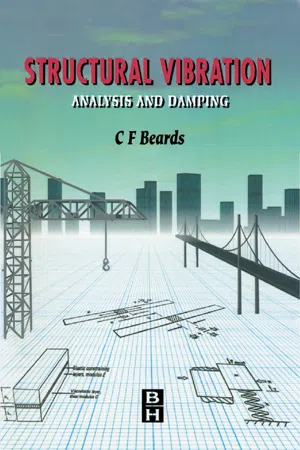Technology & Engineering
Damping
Damping refers to the process of reducing or controlling the magnitude of oscillations, vibrations, or movements in a system. It is commonly achieved by dissipating the energy of the oscillations through various means such as friction, fluid resistance, or electrical resistance. Damping is crucial in engineering to enhance stability, reduce wear and tear, and improve the performance of mechanical and structural systems.
Written by Perlego with AI-assistance
Related key terms
Related key terms
1 of 4
Related key terms
1 of 3
3 Key excerpts on "Damping"
- eBook - ePub
Mechanical Vibration
Analysis, Uncertainties, and Control, Fourth Edition
- Haym Benaroya, Mark Nagurka, Seon Han(Authors)
- 2017(Publication Date)
- CRC Press(Publisher)
Figure 3.3 Large damper installed at the Los Angeles Regional Transportation Management Center. (Courtesy of Douglas P. Taylor of Taylor Devices, Inc.)In 1999 a new Airport Rail Transit and Bay Area Rapid Transit structure (Figure 3.4 ) was constructed at the San Francisco International Airport. Ten fluid dampers were installed for earthquake energy dissipation. Two different types were employed, all with a ±508 mm stroke, some capable of resisting a 3115 kN load and others a 4225 kN load.Figure 3.4 Dampers installed at the San Francisco International Airport. (Courtesy of Douglas P. Taylor of Taylor Devices, Inc.)The Poplar Street Bridge (Figure 3.5 ), a large highway bridge over the Mississippi River in Wt. Louis, uses 64 fluid dampers to control longitudinal earthquake movement while allowing for free thermal movement. Two different types of dampers ware very, some with a ± 183 mm stroke and capable of resisting a 1334 kN load and others with a ± 229 mm stroke and capable of resisting a 2224load.kNFigure 3.5 Vibration dampers are used under the Poplar Street bridge near the Riverfront in St. Louis. (Courtesy of Douglas P. Taylor of Taylor Devices, Inc.)3.2 lntroduction to DampingDamping refers to the removal of energy from vibratory motion wed is primarily associated with the irreversible transformation of mechanical energy into thermal energy. Damping is the energy dissipation property of material and structures undergoing time‐dependent deformation and/or displacements.Depending on the mechanism of energy dissipation, Damping can be classified according to the following overlapping characteristics:6A deformation occurs when a body’s shape changes as a result of forces acting on it, whereas a displacement is a change in location of a point or points on a body. In most instances, both occur. Lumped‐parameter models idealize this situation by concentrating their mass, Damping, and stiffness properties at discrete locations.- Viscous Damping
- eBook - ePub
Wiley Series in Acoustics Noise and Vibration
Noise and Vibration Control
- Malcolm J. Crocker, Jorge P. Arenas(Authors)
- 2020(Publication Date)
- Wiley(Publisher)
Load‐bearing and non‐load‐bearing structures of a machine (panels) are excited into motion by mechanical machine forces resulting in radiated noise. Also, the sound field inside an enclosure excites its walls into vibration. When resonant motion dominates the vibration, the use of Damping materials can result in significant noise reduction. In the case of machinery enclosures, the motion of the enclosure walls is normally mass‐controlled (except in the coincidence frequency region), and the use of Damping materials is often disappointing. Damping materials are often effectively employed in machinery in which there are impacting parts since these impacts excite resonant motion. A structure that vibrates in flexure can be damped by the appropriate addition of a layer of Damping material.Damping involves the conversion of mechanical energy into heat. Damping mechanisms include friction (rubbing) of parts, air pumping at joints, sound radiation, viscous effects, eddy currents, and magnetic and mechanical hysteresis. Rubbery, plastic, and tarry materials usually possess high Damping. During compression, expansion, or shear, these materials store elastic energy, but some of it is converted into heat as well. The Damping properties of such materials are temperature dependent. Damping materials can be applied to structures in a variety of ways, for example by the application of coatings made of some viscoelastic material usually marketed in the form of tapes, sheets or sprays which may be applied like paint.An essential parameter for measuring the amount of Damping energy lost in a harmonically vibrating structure is the system Damping loss factor, η, which is defined as the ratio between the energy dissipated within the Damping layer and the energy stored in the whole structure, per cycle of vibration. Figure 9.9 shows typical ranges of the loss factors reported for materials at small strains, near room temperature, and at audio and lower frequencies. The range indicated for plastics and rubbers is large because it includes many different materials and because the properties of individual materials of this type may vary considerably with both frequency and temperature. On the other hand, since measurement of Poisson's ratio of viscoelastic materials is very difficult to obtain experimentally, data are not available for most Damping materials. Often, viscoelastic materials are assumed to be incompressible in regions of rubbery behavior and about 0.3 in regions of glassy behavior [52 ]. In general, the Damping loss factors of high‐strength materials (e.g. metals) tend to be much smaller than those of plastics and rubbers, which are of lower strength [51 - eBook - ePub
Structural Vibration
Analysis and Damping
- C. Beards(Author)
- 1996(Publication Date)
- Butterworth-Heinemann(Publisher)
Damping Applications for Vibration Control edited by P J Torvik (ASME Publication AMD, vol. 38, 1974).More recently, the Damping that can be achieved in structures has been comprehensively studied and researched, particularly with regard to industrial, military and aerospace applications, and improving analytical techniques. The results of some of this work have been published in conference proceedings and relevant learned journals such as The Journal of Sound and Vibration, The Proceedings of the ASME and The Shock and Vibration Digest .5.7.2.5 Vibration dampers and absorbers
A wide range of Damping devices is commercially available; these may rely on viscous, dry friction or hysteretic effects. In most cases some degree of adjustment is provided, although the effect of the damper can usually be fairly well predicted by using the above theory. The viscous type damper is usually a cylinder with a closely fitting piston and filled with a fluid. Suitable valves and porting give the required resistance to motion of the piston in the cylinder. Dry friction dampers rely on the friction force generated between two or more surfaces pressed together under a controlled force. Hysteretic type dampers are usually made from an elastic material with high internal Damping, such as natural rubber. Occasionally dampers relying on other effects such as eddy currents are used.However, these added dampers only act to reduce the vibration of a structure. If a particularly troublesome resonance exists it may be preferable to add a vibration absorber
Index pages curate the most relevant extracts from our library of academic textbooks. They’ve been created using an in-house natural language model (NLM), each adding context and meaning to key research topics.
Explore more topic indexes
Explore more topic indexes
1 of 6
Explore more topic indexes
1 of 4


